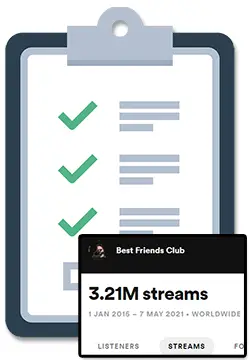When I was first taking my Spotify stats more seriously, I got confused about the difference between streams and listeners on Spotify, so I wrote about it in depth here to clear things up.
Streams are the number of times an artist’s song has been listened to on Spotify while monthly listeners are the unique number of people that have listened to any of an artist’s songs in the last 28 days.
Spotify only counts a listener as a monthly listener once in the last rolling 28-day period but will count multiple streams from that listener depending on how many times they listen to your song and how many songs they listen to.
There are a few other things to consider to really know the difference in depth, particularly in the case of listeners of a song vs what your monthly listener count is.
So is it better to have more streams or more listeners? What are monthly listeners? And, how specifically, does Spotify track streams and listeners?
Great questions! And I called those out because I obviously intend to answer them below.
So let’s hop right into it.
Spotify Listeners vs Streams
To clearly understand the difference between Spotify listeners and Spotify streams, it is important to clearly understand each separately, as well as Spotify’s streaming rules, before comparing the differences.
For a quick refresher, remember this:
- Streams are the number of times your track has been played
- Listeners are the number of people that have played your track
- Now let’s start by diving into the details of those sweet, sweet streams.
How does Spotify count a listen or stream on a song?
Spotify counts a single stream of a song when that song has been listened to for 30 seconds or more. Once the song hits the 30-second mark, a stream is counted in Spotify’s system.
This is important to note because once a stream is counted then that stream gets added to your sweet, sweet Spotify royalties in 2 to 3 months on your royalty statement.
However, you should also know that Spotify can take away streams if you are doing anything sketchy.
But why 30 seconds, you ask?
..who knows! But it is what Spotify has decided so we have to deal with it (haha).
So, whenever someone hits the 30-second mark, the Spotify For Artists listening now number will go up and you will see a new stream for that song in your Spotify For Artists dashboard the follow day.
There are also two other things to note when it comes to streams:
Do Spotify streams count on mute?
Spotify does not count streams that are on mute. While streaming, do not put the song on mute or else it will not count towards streaming counts.
To learn more details about this rule, check out my article called Do Spotify Streams Count On Mute.
Does Spotify count streams on repeat?
Spotify counts 1 stream when the song has been listened to for 30 seconds or more, regardless of what song was played before. If you listen to a song for 30 seconds and then listen to it again for 30 seconds, that will be counted as 2 streams.
To learn more details about this rule, check out my article called Does Spotify Count Streams On Repeat.
…why is this important?
It is good to know these things because they are part of the puzzle in knowing how much Spotify pays per stream.
Armed with this knowledge, you can use a Spotify royalty calculator to get an idea of how much money you stand to gain.
So!
Now that you know how Spotify counts streams, you may want to learn about when they update stream counts and what to do when your Spotify stream count is not updating.
For a more in-depth look into how Spotify streams work, check out my article on how to check spotify streams. It gives a breakdown for both artists and listeners.
Now! With stream counts out of the way, let’s move on to nailing the details of what Spotify counts as a listener.
How does Spotify count a listener?
Spotify only counts a listener as a listener if they have streamed your song at least once past the 30 second mark.
So we were pretty clear on the 30 second rule that applies to streams from before. And now we know that once someone has reached that 30 second mark for the first time they also become a listener in Spotify’s system.
Here is an important factor to remember: Spotify only counts listeners once, so if they stream the song multiple times, it still only counts as 1 listener.
When playing around in the Spotify For Artist’s dashboard, you can sometimes specify different time periods like weekly, last 24 hours, and lifetime. If you select those options, Spotify will show you the number of streams and listeners you got during that specified time period.
If you don’t have access to the dashboard, consider switching distributors to DistroKid. It is also what I use and recommend, and they make it super easy to get access.
If you would want to learn more about what DistroKid has to offer, you can check out my big fat DistroKid review.
On the other hand, if you are all set up with a distributor and just need to learn how to get access, I’ve got you covered as well, my friend.
You can learn more about getting access (with or without DistroKid) to Spotify For Artists in my article: Does DistroKid Make A Spotify Account For You?
With that said, you may have also noticed that, in addition to calculating listeners for a song and listeners over a specific time period, Spotify also mentions monthly listeners. In fact, Spotify actually displays the count for monthly listeners very prominently on an artist’s profile.
So clearly this must be important right?
It is.. to some extent. On the one hand, it is a bit of a vanity metric (a number that makes you feel good about yourself) but it could be a helpful way to track your progress and see if your audience is growing from month to month.
Let’s break down exactly what the heck monthly listeners are below and get into how they differ from streams and listeners.
Spotify Monthly Listeners vs Spotify Streams
In addition to being able to make Spotify editorial playlist submissions in your Spotify For Artists dashboard, you may have also noticed that there is a stat for monthly listeners both in your dashboard in the Audience section as well as right on your artist profile.
So what exactly is a monthly listener and how does Spotify calculate monthly listeners?
Spotify only counts a listener as a monthly listener if they have streamed any of your songs in the past 28 days. If a listener does not continue to listen to any of your music after 28 days they are no longer counted as a monthly listener.
The main difference then between monthly listeners and listeners, is that a listener is anyone who has streamed a particular song while your monthly listeners is the total amount of anyone who has streamed any of your songs in the last 28 days.
So why 28 days?
Spotify uses 28 days to calculate your monthly listeners. Spotify fully states that they chose 28 days because it is the lowest amount of days that a calendar month can have.
Because the number of days in the month fluctuates so much, they must have found it safer to stick with the lowest possible number.
They also state that they chose 28 days because this always allows for an equal amount of days to be included (ie: the same amount of Mondays, Tuesdays, etc.) This is why over time you will notice that your monthly listeners can fluctuate quite a bit: people listen to music differently throughout the week.
So which is more important to have the most of between streams and listeners?
Why It’s Important to Have More Streams Than Listeners
To some the answer to this might be pretty clear but I want to dive into the topic just to be sure. As the heading above suggests: it is important that you have more streams than listeners.
The reason for this are as follows:
- More streams than listeners mean that your fans are listening to your music on repeat.
- More streams than listeners mean that your fans are listening to a bunch of your songs.
- Having a good listener-to-stream ratio is useful for the algorithm, and, ultimately, your success on Spotify.
Both are obviously pretty important but it is important to keep an eye on your listener-to-stream ratio or your repeat listen rate.
The more that your listeners play your music on repeat, the better signals get sent to Spotify’s algorithm. This increases your chances of getting on algorithmic playlists like Release Radar and Discover Weekly.
By first focusing on algorithmic playlists, I ended up getting on over 7 Spotify editorial playlists and racking up over 300,000 streams.
So if you notice that your streams are higher than the amount of listeners you have that is a very good thing. That simply means your listeners are listening to your song more than once or are diving into your back catalog to listen to your other songs!
However, if your listeners and streams are pretty much even this can be a very bad thing.
The reason for this is because it means that people don’t like your music enough to listen repeatedly or, even worse, you are getting streams from fraudulent sources like playlists with bots, click farms, or fraudulent streams.
For more info on suspicious playlists, check out my article on Spotify Jedi for more information.
So what is the problem with these playlists?
This can result in no algorithmic playlist pushes or even your stream counts going down or even disappearing completely.
And even worse… you could even get kicked off of Spotify and your distribution service completely…
Related Questions
Why did my Spotify streams go down?
Great question!
Spotify stream counts will go down momentarily while they are in the middle of updating stream counts and permanently if Spotify believes any streams are coming from fraudulent accounts.
When it comes to Spotify’s live stream counts, unfortunately, these are known to fluctuate and in particular, can be unreliable on the last day (which is the 7th day your song has been released) that live stream counts are available.
Why is my Spotify stream count not updating?
Another great question!
Spotify only updates the audience, song, and playlist stats once per day. If your Spotify stream count is not updating, simply wait until approximately 3 PM EST.
However, Spotify can update their stats from anywhere between 8 AM EST and 5 PM EST and they simply state 3 PM EST to be safe.
What do Listeners mean on Spotify?
Another great question!
Listeners are the unique individuals that have streamed a song at least once. If someone plays a song multiple times, they only get counted once as a listener.




